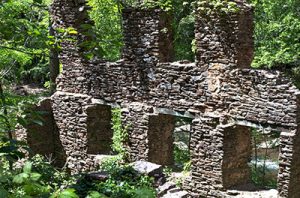(Click here to view some historical facts about CPCA.)
Prior to the advent of the settlers, this area was inhabited by Native Americans, the last of which were the Cherokees. Legends have stated that a Chief Sope lived near the Chattahoochee River between Roswell and Marietta. He was popular with early settlers because he spoke English and would teach the kids Cherokee arts like flint napping. When the Georgia Guard came to Marietta to round up nearby Indians for the Cherokee Trail of Tears in 1838, local citizens told the Georgia Guard to leave Old Sope alone. During the Civil War the Union Army referred to this as Soap Creek.
Today, some people doubt the story of Old Sope, but there is ample evidence that Sope lived along this riverbank, both in Cherokee documents and local papers, however, a search of Cherokee documents did not reveal if Old Sope was a chief. Archaeologists have uncovered fragments of their civilizations along the banks of the Chattahoochee River. According to the Cobb County Historical Map, an area in the vicinity of the present Merchants Walk Shopping Center was the site of an annual trading and games event known as the “Stop and Swap”.
It was at the confluence of Sope Creek with the Chattahoochee River that General William Tecumseh Sherman crossed the last natural boundary between his men and Atlanta. The rugged creek drops sharply in its last half-mile in a gorge formed along the Brevard Fault Line.
Work on the Marietta Paper Mill, located on Sope Creek about a half-mile above the Chattahoochee River, began in 1853 and the mill began production in 1855. Early production was centered on linen writing paper and newsprint. On December_19, 1859 the Marietta Paper Mill was incorporated, but quickly entered receivership under M. W. Sessions. At the time, buildings existed on both sides of the creek with the paper mill on the east bank and a warehouse on the west bank.
On July 4, 1860, Sessions sold the mill to C. C. Whitmire of Toledo, Ohio for $80,000. In late 1863 the mill began limited production, mostly because of problems getting rags and cotton. In March, 1864 the mill, largest in the state, was designated a primary target of the Atlanta Campaign because it manufactured the cartridge paper for Rebel guns.
When Sherman’s cavalry captured the mill on July_6, 1864 (occasionally reported as July 5) they burned it to the ground. Three days after the mill burned the first time, a few men in Jacob Cox’s 3rd Division, Army of the Ohio crossed the Chattahoochee on a Cherokee fishing dam, established a landing and began moving men across the river at an alarming rate. The following morning Lieutenant General Joseph E. Johnston withdrew from his Chattahoochee River Line.
Rebuilt after the Civil War, an accidental fire in November 1870 destroyed the main building but did not reach the powerhouse. The steam-driven wood pulp production facility of the Marietta Paper Mill was completed in 1873 upstream from the present-day bridge as demand for higher-quality linen paper weakened because of cheaper paper produced from wood.
 The date of the last production at the paper mill is normally given as 1902. A story appeared in the Athens Banner in 1907 reporting a steam engine explosion on October 8 that threw pieces of the mill’s engine 1/4 mile from the explosion. This probably occurred in the pulp mill, upstream from the Marietta Paper Mill.
The date of the last production at the paper mill is normally given as 1902. A story appeared in the Athens Banner in 1907 reporting a steam engine explosion on October 8 that threw pieces of the mill’s engine 1/4 mile from the explosion. This probably occurred in the pulp mill, upstream from the Marietta Paper Mill.

Today, more than ten miles of hiking trails can be used to explore the hills of the Chattahoochee River valley, the ruins of the Marietta Paper Mill, and Sibley Lake.


(Information cited from aboutnorthgeorgia.com)